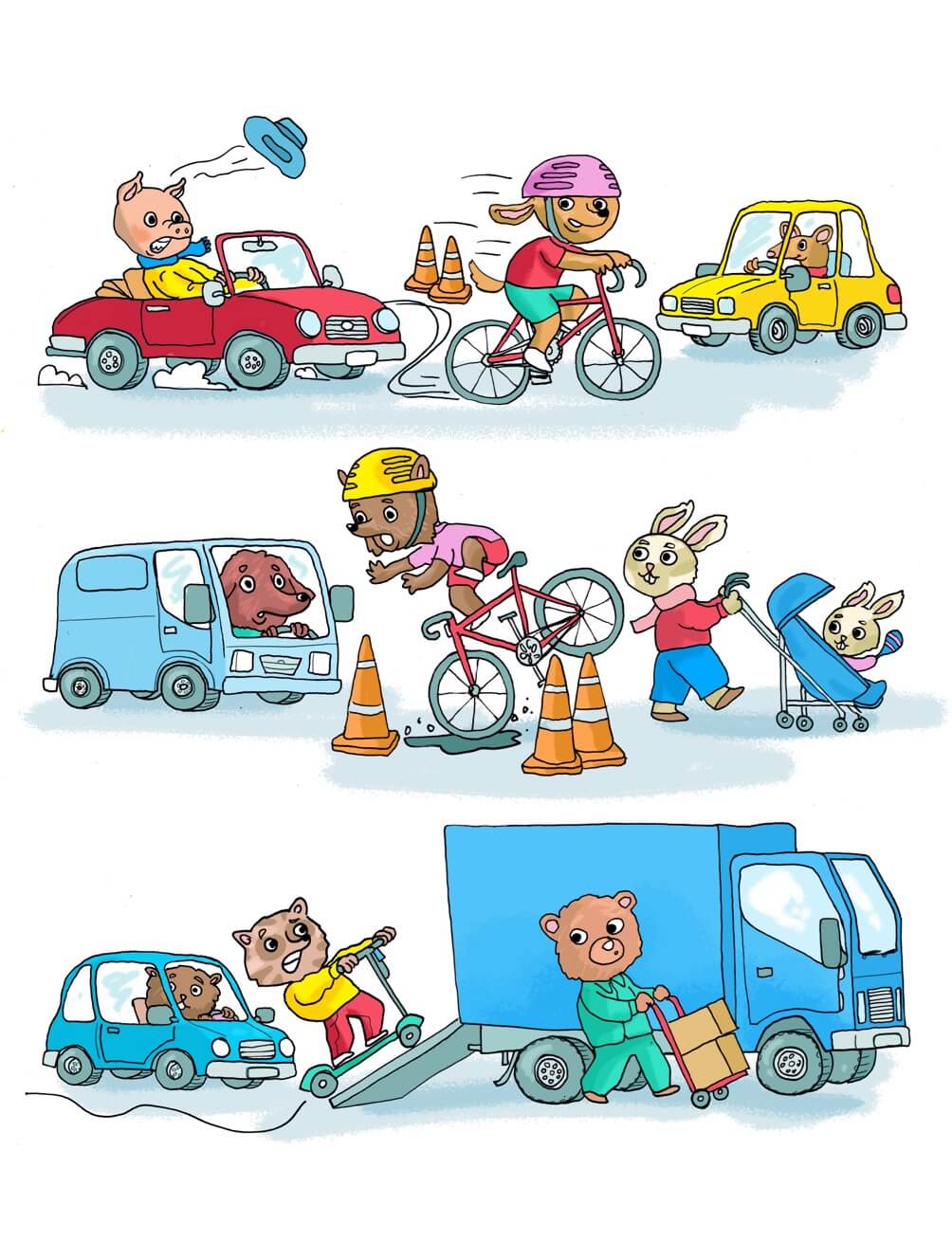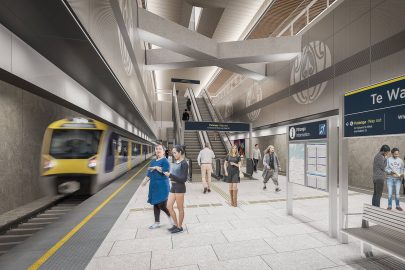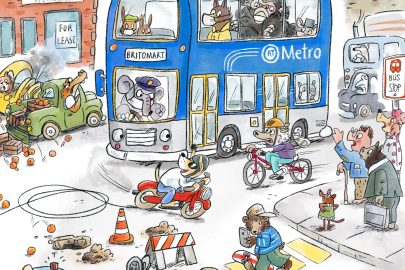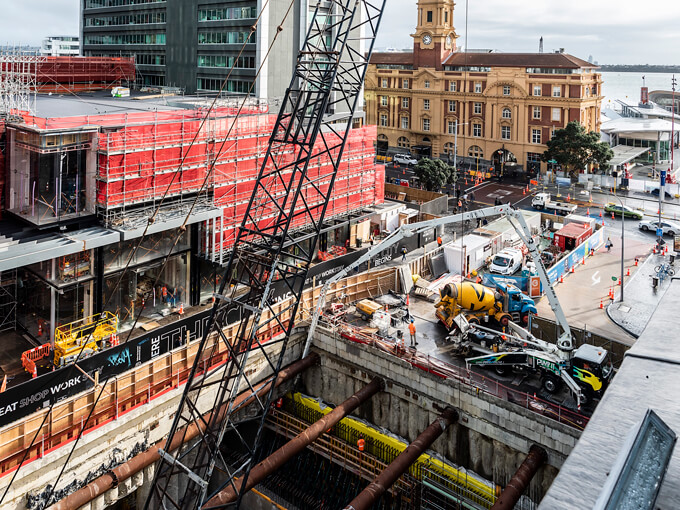Jul 17, 2023 Transport
A rush-hour driver eyes the gaps in the oncoming traffic at the northern end of Great North Rd. His car jerks forward as a sliver of space appears. A primary-school student is wheeling her bike along the footpath as he crosses the southbound lane at speed. She steps back from the intersection. His car passes centimetres from where she was moments ago.
The near-miss is a daily occurrence on the central Auckland road, where car transporters and rat-running commuters compete for space with schoolchildren and cyclists. A little later in the morning, a driver fails to check his rear-view mirror as he backs a van out of a side-street carpark. A dad yanks his son backward on the footpath to avoid a collision. Boopsie Maran winces. She used to send her children along this route to school, and has been campaigning for years to make it safer. “Every day, I thought they were going to die,” she says. “I’d wait for a call at 10am.”
There were 139 crashes on the stretch of Great North Rd between the Grey Lynn shops and Karangahape Rd between 2014 and 2019, including 11 that caused serious injuries. About 80% of those occurred at intersections. Katie Williams was taking her child to school when she arrived at the scene of one of the collisions. A boy on a scooter had been hit by a car and knocked unconscious. “We just found him one morning lying in the middle of the road,” she says. Williams has a nine-year-old child at Grey Lynn School and a 16-year-old at Western Springs College, and resents the dangers they face. “I don’t think it’s right to ask our children, especially, to take those risks.”
Some of the risks were meant to be gone by now. Transport advocates trace the first plans for safety up- grades on Great North Rd to 2007, when Dick Hubbard was mayor at Auckland City Council and the super-city was still a glimmer in the eye of future local government minister Rodney Hide. The idea has now been in gestation for longer than the entire duration of the space race between the Soviet Union and the United States, going through a plethora of consultations, business cases, redesigns and rescopes.
The latest round of feedback was meant to put an end to the pain. In 2021, the council’s transport arm, Auckland Transport (AT), held consultations on an upgrade to the stretch of Great North Rd between the Grey Lynn shops and Karangahape Rd which featured bus lanes, bike lanes, pedestrian facilities and planting and amenity improvements. Waka Kotahi agreed to pay 51% of the project’s cost, which the most recent budget puts at $28.1 million. The greatest share — $5.2 million — is set to go toward pedestrian improvements, with $3.9 million earmarked for bus lanes, $3.5 million for road resurfacing and $3.6 million for protected cycle lanes. Feedback on the plan was positive, with separated cycle paths endorsed by the greatest number of respondents (64% of those who submitted) and signalised pedestrian crossings receiving the second-highest level of support. A large number of respondents said the project needed to be “progressed quickly”. In a press release issued by AT, Grey Lynn Business Association chair Paul Stephenson called it a “once-in-a-generation chance to connect Grey Lynn to the city and build a better place for new businesses along the Great North Road ridge”. So far more than 50 organisations have come out in support of the project, including all the local schools.
It seemed AT had somehow arrived at the rarest thing in local politics: an almost universally popular plan to install cycle lanes. The project aligned with its policies, including a climate plan calling for a 64% cut to transport sector carbon emissions by 2030. AT’s head of cycling, Adrian Lord, has worked in transport agencies across the United Kingdom and Europe for 25 years, and says he’s never seen a cycle-friendly safety upgrade meet with the same positivity as Great North Rd. “We’ve been able to get a groundswell of support from across the community, not only the people who live in the area, but also people who use the area as part of their route. We don’t often get that.”
It should have been the easiest project Lord has ever got across the line. Instead the past few months have been one of the biggest struggles of his career. Great North Rd is part of a trio of safety upgrades known as the Inner West Projects, and all three were thrown into turmoil after the local election last October. One, a $28 million set of walking, cycling and bus improvements through Grey Lynn and Westmere, collectively known as the Waitematā Safe Routes, was shelved by the AT board in February. An upgrade to Point Chevalier, Garnet and Meola Rds got the go-ahead despite some negative media coverage. Great North Rd has been up in the air, as a few councillors, the newly elected mayor and a ragtag group of local activists teamed up for a last-minute, audacious and almost successful attempt at sabotage.
Transport advocates see Great North Rd as a case study for AT’s well-documented bias towards inaction and endless consultation. They say it shows how politicians can use dubious financial constraints to undermine projects they oppose on ideological grounds. But in the eyes of many of the project’s supporters, it’s also a lesson in how a small number of sufficiently vehement activists can take advantage of local government’s risk aversion. When asked why a popular, majority-government-fund- ed, shovel-ready, long-overdue project has been beset by seemingly endless delay, Albert-Eden-Puketāpapa ward councillor Julie Fairey pauses a second, then sighs. “There’s a Margaret Mead quote: ‘Never doubt that a small group of thoughtful, committed citizens can change the world. Indeed, it’s the only thing that ever has’,” she says. “That works in both directions. It works for the better and for the worse.”
In this system, if you shout long and loud enough, you can sometimes drown out everyone else.

Gael Baldock has a question for Metro before she’ll agree to an interview. “Do you cycle?” she asks. When satisfied the answer is no, she continues. “All right, fine. I’ll carry on talking to you. I just wanted to know if you were coming from the perspective of a cycle lobbyist or whether you want to have a real perspective on these things,” she says. Baldock and the diminutive, cowboy-hat-wearing activist Lisa Prager are key members of the protest group Occupy Garnet Road. They made waves in 2018 when Prager took an axe (originally misidentified by the media as a sledgehammer) to an under-construction traffic island on the corner of Richmond Rd and Surrey Cres. Though physically futile, the protest was successful in sending a message to AT. Transport advocate Matt Lowrie says safety projects across the region “ground to a halt” soon afterward. AT has adopted a tentative approach to cycling upgrades in the years since.
Prager and Baldock went on to protest against the relocation of a few pōhutukawa on Quay St to make room for a street upgrade, and the removal of some dying, dangerous pine trees at Western Springs Reserve. Council sources estimate the costs imposed by their actions are now in the hundreds of thousands of dollars. More recently, the pair turned their focus to the Inner West Projects, airing their opposition at a series of council meetings. Prager refuses to talk to Metro, but after being relieved of fears that she’s speaking to a cyclist, Baldock is more open to questions. She explains that her objections to the Inner West Projects, especially Great North Rd, are centred on cost. “Excuse me, at the moment we’ve got far more pressing issues,” she says. “First of all, we’ve got a mayor that’s come into office with a $295 million fiscal hole, thank you.”
That hole later grew to $325 million, and Baldock says it’s insulting to ratepayers to spend millions on what she sees as a pointless set of cycleways in the face of those financial headwinds. At other points, though, she seems more driven by deep hostility to cyclists and a personal animosity toward her political enemies. When Fairey’s support for the projects is raised, she’s dismissed as an appendage of her former Cabinet minister husband. “Well, if you talk to Michael Wood’s trousers, she’s gonna give an answer like that. Seriously, she comes from a place of the wokeness of cycleways,” Baldock says. Similar insults follow for other supporters of the Great North Rd upgrades. Waitematā Local Board chair Genevieve Sage is a “little trough-feeder” with “kindergarten-level” skills as a chair; her fellow board member Richard Northey is only interested in getting his “little nose in the trough”; former Waitematā and Gulf ward councillor Pippa Coom is a Bike Auckland “mouthpiece”; and all of the above are “spoiled brats” who are “throwing their dummies and their rattles out of the cot”.
These types of harsh, often ad-hominem attacks are a staple for Occupy Garnet Road. Both Prager and Baldock tend to demonise those they disagree with. Despite the fact he left the role in 2019, Baldock repeatedly refers to former Auckland Design Office manager Ludo Campbell-Reid as “ludicrous Ludo” because he once urged the council to design streets for people travelling by foot or bike rather than just by car. She stereotypes Chinese, Indian and Pacific drivers in an extended spiel about how AT employs too many foreign workers who don’t understand New Zealand’s transport culture. Prager routinely yells over her opponents in political meetings. She has a reputation for aggressive, sometimes even threatening, language. In a 2014 interview with the conspiracy theorist Vinny Eastwood, she spoke approvingly about the concept of guillotining a council leader she was feuding with at the time, along with other global “puppet masters”. Eastwood responded, mimicking the sound of a noose tightening: “Yes, well, I’ve always been a fan of hanging them myself. In a ceremonial-type fashion. After all their crimes have been read out.”
It would be tempting to dismiss Occupy Garnet Road as kooky fringe activists if they didn’t appear to have support in the upper echelons of Auckland Council, including Wayne Brown and Waitematā and Gulf councillor Mike Lee, the two politicians most responsible for slowing progress on the Inner West Projects. Baldock and Prager have been granted speaking slots at AT board meetings, the council’s transport and infrastructure committee and repeatedly in front of the Waitematā Local Board. In early June, they were among a select group of media members and other observers Brown allowed to attend a presentation on his proposals for the annual budget. Stuff, TVNZ and Newshub were excluded.
Though Metro’s request under the Local Government Official Information and Meetings Act (LGOIMA) for texts between Baldock and Brown yielded no results, he’s posed for photos with his arm around her shoulders and multiple people have seen the pair communicating. Grey Lynn Residents Association committee member Brandon Wilcox sat next to Baldock in the March meeting of the transport and infrastructure committee. “Wayne Brown was giving sign language to Gael. They were messaging each other about stuff as it was going along,” he says. Later in the meeting, Brown put a series of pointed questions to AT staff, including several about whether a cycleway could be taken off Great North Rd’s carriageway and installed on the footpath. Soon afterward, an alternative project design from Baldock was circulated among sympathetic councillors. It featured a painted cycleway on the footpath. “Gael’s plan is what Wayne Brown was saying at the transport and infrastructure committee meeting, put into writing. Like word for word, picture for picture,” Wilcox says.
A similar synergy exists between Prager, Baldock and Lee. In his February presentation to the Waitematā Local Board, Lee thanked Prager for “eloquently” putting the case against upgrading Great North Rd, affirming he, too, was “totally opposed” to the project. At a November 2022 meeting hosted by the Act Party, Lee echoed one of Prager and Baldock’s repeated refrains, arguing infrastructure companies are pushing for expensive cycleways to be built as a way of generating revenue for themselves. Fairey, Coom and several local residents, including Wilcox, say it’s fair to say Baldock and Prager have gained the ear of people around the council table.
Baldock herself says the only connection between her, Prager, Brown and Lee is that they “think sensibly”.
“I haven’t got Wayne Brown on side. He’s not in anybody’s pocket,” she says. “He’s not on anyone’s side other than the side of common sense. Are we just on a very similar page? Sure. He’s not in my pocket.”
Even if its influence can be overstated, Occupy Garnet Road has been useful for the politicians who successfully pressured AT to delay Great North Rd. Its loud, aggressive campaign has created the illusion of deep community division where little to none exists. In emails to constituents obtained under the LGOIMA, Lee repeatedly refers to controversy over the Great North Rd upgrade, despite the almost universal support indicated by consultations and the large number of community groups, business associations, schools and other organisations calling for the project to go ahead without delay. In one email, he describes it as “exorbitantly expensive, intrusive, disruptive, unpopular”. When he hears from a constituent who supports the project, he forwards the message on with a sceptical comment: “This looks like it was written with the help of the AT comms department.”
The supposed division has been reported as fact by the New Zealand Herald, which has quoted Lee in stories obscuring the real cost breakdowns of the Inner West Projects and calling them a “controversial $100 million programme of inner-city cycleways” or, in the case of Meola Rd, a “$35 million cycleway for wealthy inner-city suburbs”. Other local politicians have added to the noise. Waitematā Local Board member Greg Moyle has been outspoken in opposition to the Great North Rd upgrade, once earning a rebuke from Sage after aggressively interrogating a high-school student who presented to the board in favour of the project. Moyle’s colleague Sarah Trotman is more measured in her opposition, though she has a history of fiery confrontation in the service of causes she shares with Prager and Baldock: in 2021, she was arrested after occupying a digger at the tree removal site in Western Springs.
Nearly all these opponents say the same thing: the Inner West Projects are too expensive. “I just sleep easy at night, knowing that we are not spending money in this very difficult time for New Zealanders who have just come through Covid,” says Trotman. But the two remaining projects represent a sliver of AT’s $1 billion annual capital budget, and their costs currently come at a 51% government discount. Instead, many of the objections seem rooted in a culture war over cycling. Brown, Lee and Moyle are hostile to the idea of allocating any of Great North Rd to bikes. “I have no problems with kids cycling on the footpath,” says Moyle, before skirting close to what transport advocates see as the point of protected cycleways. “Young people cycling on main roads is flaming dangerous.” Brown has gone one step further. Following his questions in March at the transport and infrastructure committee, he was snapped by the Herald biking on Great North Rd’s footpath in an effort to prove it’s a viable cycle route. Just weeks later, a car crashed into the bus stop he was riding beside in the photo.
A braver agency than Auckland Transport might have dismissed these objections. Before last October’s election, the three Inner West Projects were essentially a done deal. The funding was sorted. Early works were already under way on Great North Rd. Letters had been sent to local residents warning them construction was about to start. AT just had to hold out another month or two. Instead, internal emails show it quickly changed course after Brown wrote an open letter to AT accusing it of being too “focused on changing how Aucklanders live”. “Instead, AT must seek to deeply understand how Aucklanders actually live now, how they want to live in the future and deliver transport services that support those aspirations.” Lee immediately jumped in with his own letter, imploring the mayor to instruct the agency to put a halt to the Inner West Projects.
Neither letter had any statutory power and both appeared to clash with existing policies and strategies on safety improvements and emissions reductions. Nevertheless, AT’s acting chief executive Mark Lambert responded with an all-staff meeting where he announced some cycling projects would be put on hold. Internal emails obtained under the LGOIMA show the agency called a series of meetings in early November to talk about what AT manager and chief engineer Murray Burt called the “Waitematā Cycleways go/no decision”. AT executives emerged with several potential courses of action, including “descoping” parts of the projects and going back to local boards to reaffirm their support. The option of retaining the projects in their current form wasn’t listed.
A reply email from Adrian Lord betrays a level of alarm. “I’d be cautious about descoping unless there was a very substantial cost saving from doing so,” he wrote on 17 November. “We’ve gone through six years of adding scope into these projects to satisfy concerns from local stakeholders and create a ‘dig once’ package. If we go out with a compromised scheme we will inevitably just upset everybody, lose all political and stakeholder support, and all trust from Waka Kotahi and other partners that we can deliver what we promise when we next apply for funding.”
AT went within a hair’s breadth of taking the course of action that gave Lord conniptions. Its staff sent more than 10,000 emails on the Inner West Projects between 19 October 2022 and 28 February 2023 — a total of 113 per working day. Lord worked to save all three upgrades, pre- senting on their benefits to the AT board, winning majority support for the projects from the Albert-Eden and Wait- ematā local boards, and taking councillors on a site visit to Great North Rd. It wasn’t enough to save Waitematā Safe Routes. Lord blames AT’s caution and capitulation partly on cycling being an easy political football. He also sees a failure to give appropriate weight to objectors like Occupy Garnet Road. “It’s a problem for democracy at the moment. But we don’t have a way to filter these people out or to give them the correct level of recognition alongside all the other voices,” he says. AT’s new chief executive, Dean Kimpton, who started in April, shares some of Lord’s concerns with how the saga has played out. “It’s frustrating,” he says. “It’s frustrating for the organisation, too.”
It’s been even more frustrating for the people who live and work near Great North Rd. Wilcox and his fellow Grey Lynn Residents Association committee member David Batten are into their seventh year trying to get Great North Rd upgraded. They were given a $10,000 grant by Waitematā Local Board in 2016 to support development of a community-led plan for the road. They surveyed locals on their preferences, setting up interviews with their members, running an online poll and hiring a student to walk the street talking to pedestrians and business owners. About 70% of respondents, without being prompted, said they’d like cycleways. More than 80% wanted to see the road turned into a tree-lined boulevard. AT’s plan was a watered-down version of that idea. Over the past few months, even that cheaper option was labelled “gold-plated” by Lee.
Wilcox feels like he’s been wasting his time. “We’re incredibly frustrated. We were on the verge of getting this project through, and all of a sudden we had the rug pulled out from under us,” he says. Bruce Copeland, the outgoing chair of the Ponsonby Business Association, who employs 150 people through his software development company Sandfield, says the delay doesn’t make sense. “It’s just a complete disrespect to the process. There was a very rigorous process, arguably too rigorous. We had people bending over backwards trying to understand and incorporate people’s concerns in the design.”
Jamey Holloway, manager of the Karangahape Road Business Association, is similarly unimpressed. “It’s madness,” he says. “It does seem that 100 people who are in favour can get pushed off the ball by five people who are not in favour and willing to die for the cause.” Holloway has direct experience of a street upgrade similar to the one proposed for Great North Rd. Karangahape Rd’s revamp was completed in 2021, and business has been booming since, he says. “Our Covid bounce-back has been quicker and better than most other parts of the city because the main impact of the cycleways is actually to make the street more enjoyable for pedestrians. It slows down the cars and provides a lot of extra space for outdoor dining. I would say the cyclists are the third or fourth beneficiaries of the cycleway on Karangahape Rd.”
Mark Todd, co-founder of the property developer Ockham, is more blunt. “The lack of an aspirational vision is another example of this selfish older generation riding it out until they’re all in a box, with no consideration for the future and our future mokopuna. They’re just selfish fucks,” he says. Ockham has already completed a 32-apartment development just off Great North Rd, and is building a 155-apartment complex named The Feynman on the road itself. That investment was predicated partly on the potential Todd sees in the area. His faith is being undermined by what he says is a council refusing to follow its own policies. “We have a car-centric city with traffic problems for Africa and everyone whinges whenever someone tries to do the right thing. They talk about how we need to be a quality compact city, but all the emphasis is on doing things in the wrong places that nobody wants.”
Pia Gahagan, who has a child at Newton Central School, recently experienced some of those remonstrations first-hand. She presented to the AT board alongside Maran and Bike Auckland officer Fiáin d’Leafy in late May. Their last-ditch attempt to convince the organisation to restart the project was interrupted by a loud objection from the public gallery. “Give me an uncongested city without roadblocks everywhere,” Prager shouted. “They can use alternative streets around my neighbourhood. There’s plenty there to use.” Gahagan finished the presentation and left for work. As she exited through AT’s foyer, she walked past several green signs emblazoned with the words “safety is at the heart of everything we do”.
“If safety is at the heart of everything they do, why aren’t they pressing on with changing this?” she asks Metro. As she sees it, AT’s heart hasn’t really been the issue. The problem has been its spine. “It’s just kind of nuts that something’s been planned for so long and has just stopped. We need to press on.”
At the June meeting of the AT board, there are signs that message is getting through. AT’s staff have arrived offering a compromise project — the “descoped” design Lord once warned of. It cuts back on safety features for cyclists and pedestrians, getting rid of concrete bike lane protectors and raised tables at intersections. Lee says even that is too much. He calls on AT to put the cycleway on the footpath and ditch its plans for permanent bus lanes. “This project is disproportionate, and I think that it’s time to move on. I think we need to go back to the drawing board,” he says. Baldock is granted another speaking slot to say essentially the same thing. She touts her self-made 13-point plan for a pared-back street upgrade. “I came up with a plan. I came up with some very good ideas for the design,” she says.
But this time the board isn’t backing down. One after another, the members echo what Maran, Gahagan and a host of local organisations have told them for months on end. They can’t go back and consult on another design. They can’t compromise safety for local schoolchildren. They can’t keep having these same debates, meeting after meeting. The project goes to a vote. It’s 6–2 in favour of restarting the project in its original form, with only Lee and his fellow councillor Andy Baker voting against. There’s just one challenge still to meet. “Now I’m sure the executive will do everything they can to find the money,” AT board chair Wayne Donnelly says after the vote is taken, as Kimpton sits back and smiles a little ruefully. As it turns out, some of the project’s funding has disappeared during the delay, and AT now has the budget only for one year of its two-year construction. Kimpton gets the job of scaring up the extra cash.
It’s taken eight months, but the Great North Rd upgrade is almost back to where it was in October 2022. After the meeting, Maran strikes a cautious tone. “Do I even celebrate?” she asks. “This is what it took to get us back to where we were last year.”
But she’s already moving on. AT has also hit pause on planned pedestrian improvements at Three Lamps on Ponsonby Rd after Brown targeted it as wasteful spending in a speech on his council budget. Maran and other community advocates say the decision jeopardises the safety of 500 local schoolchildren. They’re planning to go into bat for the project. One long battle is over. The next one begins.
This story was published in Metro N°439.
Available here.







